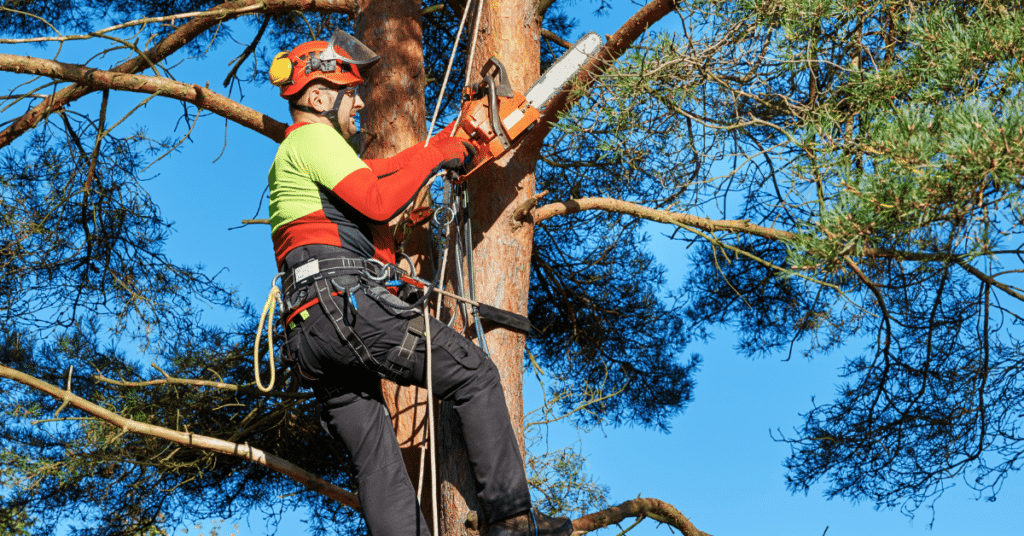By: Shelby McCullough| Published: June 4, 2024
Tree pruning is an essential practice for maintaining the health and beauty of trees. Proper pruning not only enhances the visual appeal of your landscape but also promotes the longevity and structural integrity of the trees. In this comprehensive guide, we will explore the numerous benefits of tree pruning, the best practices, and the impact it can have on your property.
Benefits of Tree Pruning
- Health Improvement
- Removal of Dead or Diseased Branches: Pruning helps eliminate dead, dying, or diseased branches, preventing the spread of decay and improving the overall health of the tree.
- Enhanced Growth: By removing specific parts of the tree, resources such as water and nutrients are more efficiently distributed to the remaining healthy parts, promoting vigorous growth.
- Safety
- Prevent Accidents: Overgrown or weak branches can pose significant safety hazards. Pruning reduces the risk of branches falling and causing injury or damage, especially during storms.
- Clearance for Structures and Power Lines: Regular pruning prevents branches from encroaching on buildings and power lines, minimizing the risk of property damage and power outages.
- Aesthetics
- Improved Appearance: Pruning shapes the tree, enhancing its natural form and beauty. This contributes to a well-maintained and attractive landscape.
- Increased Property Value: A well-pruned tree can significantly boost the curb appeal and value of your property.
- Fruit Production
- Quality and Quantity: For fruit-bearing trees, pruning is crucial for improving the size and quantity of the fruits. By allowing more light and air to penetrate the canopy, pruning fosters a healthier environment for fruit production.
- Sunlight and Air Circulation
- Better Light Penetration: Pruning allows more sunlight to reach the inner parts of the tree and the plants below it, promoting photosynthesis and the health of the entire garden.
- Increased Airflow: Improved air circulation reduces the risk of fungal infections and other diseases.

Best Practices for Tree Pruning
- Timing
- Seasonal Considerations: The best time to prune most trees is during their dormant season (late winter to early spring). This minimizes sap loss and reduces the risk of pest infestation and disease.
- Specific Needs: Some species may require different timing based on their growth cycles and specific needs.
- Tools and Techniques
- Use the Right Tools: Ensure you have the proper tools, such as pruning shears, loppers, and saws, and that they are clean and sharp.
- Prune at the Correct Spots: Cut branches at the node, the point where one branch or twig attaches to another. Avoid cutting too close to the trunk or leaving a stub.
- Types of Pruning
- Crown Thinning: Removing selective branches to reduce the density of the tree, allowing light penetration and air movement.
- Crown Raising: Removing the lower branches to provide clearance for buildings, vehicles, pedestrians, and vistas.
- Crown Reduction: Decreasing the overall size of the tree, often for utility line clearance or to reduce stress on branches.
- Safety Precautions
- Personal Safety: Always wear protective gear, such as gloves, safety glasses, and helmets. Ensure you have a stable position while pruning, especially when using ladders or climbing trees.
- Tree Health: Avoid over-pruning, which can stress the tree and make it more susceptible to disease and pests.

Common Misconceptions About Tree Pruning
- Pruning is Harmful to Trees
- While improper pruning can damage a tree, following best practices actually promotes the tree’s health and longevity.
- All Trees Should Be Pruned the Same Way
- Different tree species and individual trees have unique needs. Pruning practices should be tailored to each tree’s specific requirements.
- Pruning Can Be Done Anytime
- Timing is crucial. Pruning during the wrong season can lead to poor wound closure and increased susceptibility to disease and pests.

FAQs
- What is the Best Time to Prune Trees?
- The best time to prune most trees is during their dormant season (late winter to early spring). However, some trees, like flowering varieties, should be pruned after blooming.
- How Often Should Trees Be Pruned?
- This depends on the tree species and its growth rate. Generally, young trees should be pruned every 2-3 years, while mature trees can be pruned every 3-5 years.
- Can I Prune My Trees Myself?
- While minor pruning can be done by homeowners, it is recommended to hire a certified arborist for large trees or major pruning tasks to ensure safety and proper technique.
- What Tools Do I Need for Pruning?
- Essential tools include pruning shears, loppers, pruning saws, and pole pruners. Ensure all tools are sharp and clean to make precise cuts and prevent disease spread.
- What are the Signs That a Tree Needs Pruning?
- Look for dead, dying, or diseased branches, branches growing too close to power lines or structures, and limbs that are crossing or rubbing against each other.
Conclusion
Tree pruning is a vital practice for maintaining the health, safety, and beauty of your trees and landscape. By understanding the benefits and best practices, you can ensure your trees thrive and continue to enhance your property for years to come. For the best results, consider consulting with certified arborists, such as those at McCullough Tree Service, who offer professional and comprehensive tree care services. Proper pruning not only enhances the visual appeal of your property but also contributes to the long-term health and safety of your trees.
Interactive FAQ Section
- Why is tree pruning important?
- Tree pruning is essential for maintaining tree health, preventing safety hazards, improving aesthetics, and promoting fruit production.
- When is the best time to prune trees?
- Late winter to early spring is generally the best time to prune trees, as they are dormant and less prone to disease and pest infestations.
- Can I prune my trees myself?
- Minor pruning can be done by homeowners, but major pruning tasks should be handled by certified arborists to ensure safety and proper technique.
- What tools do I need for pruning?
- Pruning shears, loppers, pruning saws, and pole pruners are essential tools. Ensure they are sharp and clean to make precise cuts and prevent disease spread.
- How often should trees be pruned?
- Young trees should be pruned every 2-3 years, while mature trees can be pruned every 3-5 years, depending on the species and growth rate.
- What are the signs that a tree needs pruning?
- Dead or diseased branches, branches growing too close to power lines or structures, and limbs that are crossing or rubbing against each other are signs that a tree needs pruning.
By following these guidelines and understanding the importance of tree pruning, you can ensure the health and longevity of your trees while enhancing the beauty and safety of your property. For expert tree pruning services, consider consulting with professionals like McCullough Tree Service, who can provide the care and expertise needed for your trees.

